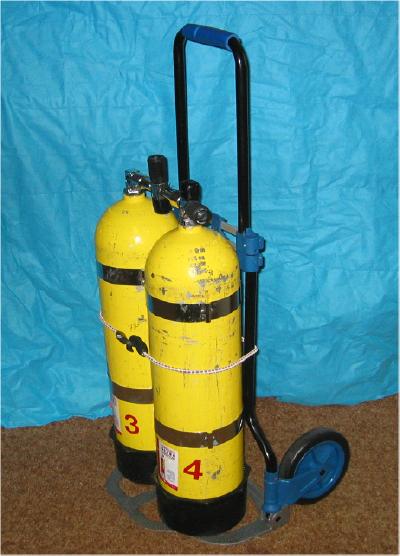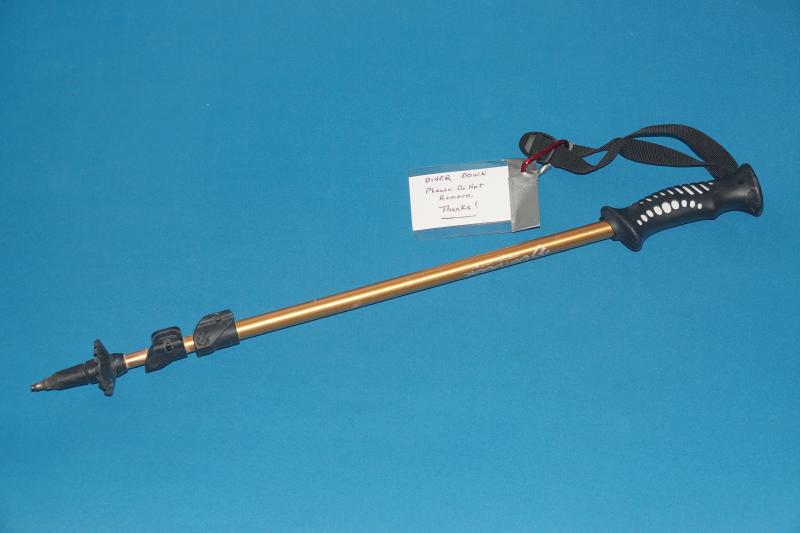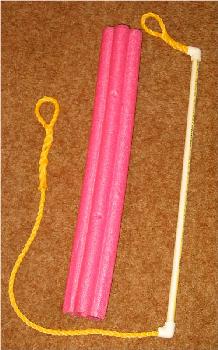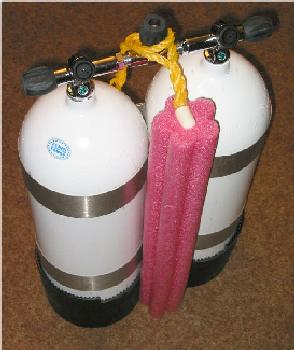 |
 |
|
Folded Cart |
Cart With Twin "80's" |
Handling "Doubles"
by
Larry "Harris" Taylor, Ph.D.
This material is copyrighted and the author retains all rights. This article is made available as a service to the diving community by the author and may be distributed for any non-commercial or Not-For-Profit use.
All rights reserved.
Go To: Home About "Harris" Articles Slides War Stories Editorials Links Fini
Doubles (two scuba cylinders connected with a common manifold) are heavy and awkward. They typically weigh between 70 and 105 pounds (30-48 kg). For example, my double 80's weigh 75 pounds (34 kg) empty and 86.5 pounds(40 kg) full. My double 95's weigh 91 pounds (41 kg) empty and 103.5 pounds (47 kg) full. Below are a few non-diving utensils that I have added to my equipment locker to assist me in handling the cylinders.
A Cart
I found this "Bench Top Pro." cart below at a K-mart. This metal (all but wheels) cart folds for easy storage (20" x 28" x 3"; 51 cm x 71 cm x 8 cm) and transport. It quickly opens to a small cart ideal for a set of doubles. The cart is used primarily for moving the cylinders over flat surfaces, especially between my SUV and the dive shop for gas refills. I added a small bungee cord as a safety margin for securing the cylinders. The cart and the bungee cord together had a cost of about $40.00.
Although I like the small folded size of this particular cart, any cart that is easily transported will make the transfer of heavy multiple cylinders from a vehicle to fill-station or charter boat a much easier task.
 |
 |
|
Folded Cart |
Cart With Twin "80's" |
The twin 80's were my first set of doubles and the manifold between the cylinders is a Benjamin Cross-over. It shows, as one dive vendor commented, that I "am steeped in tradition" (probably the politically correct way of saying "old diver.")
The Strap
The cart is useful only in relatively flat areas and is almost totally useless for severely inclined or stair step areas. For these regions, I use a shoulder strap (thanks to Tyler Schultz of Michigan Adventure Diving for the shoulder strap idea.). I use a cam-shackle on a 6 foot strap. The cam shackle has the advantage that the buckle will not slip under tension. This particular model is rated at holding 2500 pounds of thrust with a dead load of about 800 pounds. (I prefer a rating far in excess of anticipated load). I added a large padded not-for-climbing-carabineer to firmly hold the tanks when they were attached to the strap. Finally, I added a couple of automobile seat-belt pads (one to hold the excess strap and the other as a shoulder pad). The total cost for two strap assemblies (the cam-shackle I chose came only as a set of two.) was less than $40.00. As a bonus, my Jeep Cherokee has a set of rings in the rear floor board, so I use the second cam-shackle strap to secure the scuba cylinders resting in the storage transport rack (see Scuba Storage Rack. ) when carrying cylinders in my vehicle.
When using the strap, it is important that the exposed end of the bolts securing the cylinder bands be oriented away from the diver. Otherwise, it is possible that the extended bolts can scrape against or cut into the leg when the set of doubles is lifted from the ground. This is especially critical when wearing shorts.
|
|
 |
|
The "Strap" |
Using the Strap (with Twin 95's) |
The Stick
While to me the easiest way to dive doubles is to put them on, walk a minimum of steps, and then "fall-off a boat," this type of diving is not always possible. Besides, sitting buoyancy and trim, rigging new equipment configurations, and just plain practicing swimming with the increased weight of a set of doubles is often done from shore. Sometimes, shore entry can be a bit precarious. To facilitate my entrance and exit, I use an extended collapsible hiking staff (Trek Staff, available from Wal-Mart for $15.00 ... I see no point is using an expensive hiking staff that is only going to be used for in-water exits and entries. Besides, if someone steals my stick while I am diving, it is not a major loss of expensive hardware). I use a tie-wrap to add a self-laminated copy of my business card to the tool . On the back of the card is a hand-written note that reads, "Diver Tool In Use, Please Do Not Remove. Thanks." When diving, I use the staff to assist my going from parking lot to in-water; I leave the staff at the entry/exit point, do the dive, and then retrieve the tool for exit.

The Foam Bolt Protector
My doubles are typically stored or transported without being attached to their back-plate. This makes the exposed cylinder bolts a potential snag source. Additionally, the exposed bolts are vulnerable to being damaged or bent. To prevent snagging or damage to my bolts during storage or transport, I have added a layer of foam (in the form of a "swim noodle") around the bolts. The swim noodle is impaled by the cylinder bolts and held into place with a short strand of polypropylene line. To minimize damage to the foam by the line, I have encased the line in 1/4" PVC pipe using a straight piece of pipe and 2 right angle adaptors. This is shown below:
 |
 |
 |
| Protector Components | Foam in Place | Assembled Protector |
Conclusion
While it is certainly not necessary to have "accessories" for handling multiple cylinder configurations out-of-water, they do make the transport of these heavy packages a bit more convenient. As the "Easy Diver" always says, "Dive with your brains, not your back!"
Go To: Home About "Harris" Articles Slides War Stories Editorials Links Fini
About the Author:
Larry "Harris" Taylor, Ph.D. is a biochemist and Diving Safety Coordinator at the University of Michigan. He has authored more than
200 scuba related articles. His personal dive library (See Alert Diver, Mar/Apr. 1997, p. 54) is considered by one of the best sources of information in North America.
All rights reserved.
Use of these articles for personal or organizational profit is specifically denied.
These articles may be used for not-for-profit diving education